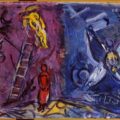A Mother’s Jealousy, A Mother’s Love

Laura van Prooyen’s new collection Our House Was on Fire reads like a fairy tale. Like so many fairy tales, the poems relate a difficult mother-daughter relationship, in which the mother’s own desire undermines her maternal instincts and abilities. A mother is supposed to be domestic, comforting, willing to sacrifice her own needs and desires for those of her children. The mother-narrator in these poems, though sometimes self-effacing, also gives in to her less noble feelings and instincts. Even ordinary household objects arouse her jealousy—the book’s title comes from the poem “Blanket”:
I know it’s wrong,
but tucking my daughter in bed
I ask: If our house was on fire
which would you choose?
She says: My blanket, Mom,
’cause you can run.
Mothers, in today’s rendition of motherhood at least, are not supposed to feel jealousy, and van Prooyen’s narrator prefaces her admission, “I know it’s wrong.” But in fairy tales, mothers take their jealousy to extremes, and thus fairy tales allow for a breadth of emotion that modern values refuse to allow.

Our House Was on Fire
by Laura van Prooyen
Softcover, $15.95
Ashland Poetry Press, 2015
The daughter’s decision to save her blanket cuts two ways. Surely, if she had to choose one, the blanket is the safer bet. The mother can run—can abandon her—while the blanket will never leave her side. Alternatively, the mother can run—can fend for herself in an emergency—whereas the blanket has no other recourse. The daughter’s protective instinct tells her that while she loves her mother, she has a responsibility to the blanket. It’s a familiar pattern. Someday the little girl may become a mother herself, and then her primary responsibility will be to her own children, while they think of themselves. It articulates an almost Freudian pattern of dependence and rejection across the generations.
In contemporary versions of the “Snow White” tale, the Queen orders proof of Snow White’s death in the form of her heart, the center of her passion and desire. Van Prooyen’s mother-narrator has desires of her own, but they exist only in memories, wistful entreaties, as in “Happiness”:
… But remember
I am the girl who, long before you,hopped on the back of some guy’s bike never thinking
he could drive me to the cornfieldand leave me there when he was through.
More cautious now, the mother’s present-day desires seem half-hearted, or at least easier to resist. “Revision” contains a later version of the scene in “Happiness,” one in which she makes a more considered choice:
The neighbor invites me
for a ride on his bike. I think yes. I say no.
Our daughters hear me and laugh.
And the dynamic resurfaces in “Intersection”:
I drive my children
past the forest where
we did not go. My skirt
is not so short anymore.
There’s a strong connection between identity and desire on one hand, and the totalizing power of motherhood on the other, which forces the mother to displace personal feelings into the past to allow space for her new role in the present. Compare this to the daughter, whose heart is portrayed in poem after poem as “a heart/full of needles,” “open,” needing to be tamed, pricked and pinpointed. In “How Quickly Nothing is Familiar,” the daughter ventures into the woods after a man; despite (or perhaps because of) her guilelessness, she comes out unharmed:
My daughter runs the worn path. Her pink jacket
bright as bubblegum, or lipstick. Orthe bougainvillea I once potted in Texas
far from these woods
The color pink seems to signify girlhood, changing from bubble gum to lipstick to the suggestive image of a flower in bloom. “The worn path” could lead anywhere: toward the daughter’s first love, toward her independence from the mother and the family unit, even toward her eventual death. The poem ends:
She runs toward the river, a bloom
in a tunnel at the bend where the man
disappears. Before I think to say no.
“Before I think to say no,” as if she lacks the agency to say no, as if it is the mother’s decision to make. The daughter, too, can run.
There is a long tradition in poetry of drawing on fairy tales in order to contextualize one’s own experience. Anne Sexton’s Transformations famously re-imagines several of Grimm’s fairy tales, often emphasizing the misogyny inherent in these foundational tales, and thus in the culture at large. Sexton’s Snow White is a delicate, virginal creature with “cheeks as fragile as cigarette paper, / arms and legs made of Limoges, / lips like Vin Du Rhone.”
Sexton’s doll metaphor renders the little girl so delicate as to be almost inhuman. The daughter in Van Prooyen’s poems, however, is perhaps too human. But like Sexton’s Snow White, she lives in a world not safe for little girls. There are dangers lurking around every corner. Sexton describes the fairy tale heroine’s journey through the woods:
At each turn there were twenty doorways
and at each stood a hungry wolf,
his tongue lolling out like a worm.
The birds called out lewdly,
talking like pink parrots,
and the snakes hung down in loops,
each a noose for her sweet white neck.
Though Van Prooyen’s narrator has a less cynical worldview, the mother and daughter face equally significant dangers, including the daughter’s serious illness. The mother says “before her heart defies us both,” and she means the girl’s broken body, her failing organs, and not only the heart’s desires, may go against what they both want for her. Conventionally, the mother has wisdom, and knows what is best for her child. In this case, though, the daughter possesses experience and knowledge, tragic and well beyond her years. In “Undoing Her Hair,” van Prooyen tells the story in third person, as an onlooker:
her child
curled up, delirious
at the onset of disease
and know the more
the body fails, the more
the girl speaks of what
the mother cannot see
At the end, the mother realizes the error in her thinking: “she can’t believe / she ever thought / this girl belonged to her.” The knowledge the daughter has gleaned through her illness creates distance, as if the disease has already taken her. In “Undertow,” the narrator describes
the girls gone out and soon
gone under, the mother who reaches
one, not the other.
The steady rhythm and near-rhyme at the end (under/other), almost Mother Goose-like in its simple matter-of-fact-ness, belies the mother’s deep-seated fear of loss. Other poems, such as “Arch,” convey her urgency through short, pointed lines:
Her belly sinks,
stretches over her organs,
the one that has failed
and another I know
is leaking
As the book progresses, a sort of reconciliation takes place, though the daughter is still threatened by illness, the relationships still imperfect. The mother-narrator reconciles her fears for her daughter with the ability to take pleasure in her daughter’s small joys and everyday triumphs:
I braid my daughter’s hair
and remind her not to take the shortcut
through the Laundromat or the alley.I know the world can be broken,
yet beautiful. I want to believe lonelinessis not menacing, but can be a window
from which I watch her walk away.
In so many fairy tales, only the mother’s death or some extreme cruelty can provide her children with a modicum of independence. The parents of today’s world walk a finer line, and van Prooyen’s narrator seems to have achieved this difficult balance: cautioning her daughter on the way out, she nonetheless allows her to walk away, to explore the broken and beautiful world on her own.
About Liza Katz
Liza Katz is a poet, essayist, and teacher. Her work has appeared or is forthcoming in Poet Lore, Omniverse, Burlesque Press, the Quarterly Conversation, and Arts Fuse.





